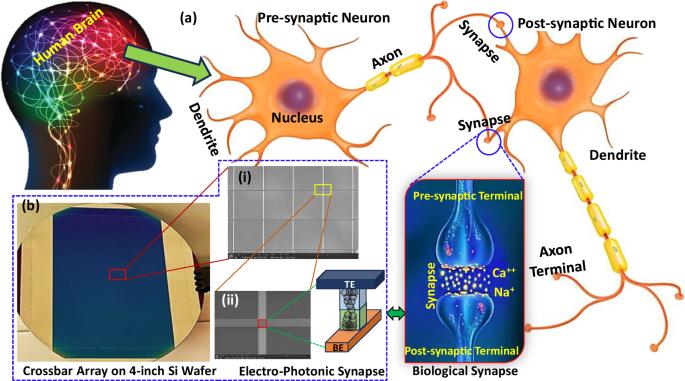Negative photo conductivity triggered with visible light in wide bandgap oxide-based optoelectronic crossbar memristive array for photograph sensing and neuromorphic computing applications
引用次数: 0
Abstract
Photoresponsivity studies of wide-bandgap oxide-based devices have emerged as a vibrant and popular research area. Researchers have explored various material systems in their quest to develop devices capable of responding to illumination. In this study, we engineered a mature wide-bandgap oxide-based bilayer heterostructure synaptic memristor to emulate the human brain for applications in neuromorphic computing and photograph sensing. The device exhibits advanced electric and electrophotonic synaptic functions, such as long-term potentiation (LTP), long-term depression (LTD), and paired-pulse facilitation (PPF), by applying successive electric and photonic pulses. Moreover, the device exhibits exceptional electrical SET and photonic RESET endurance, maintaining its stability for a minimum of 1200 cycles without any degradation. Density functional theory calculations of the band structures provide insights into the conduction mechanism of the device. Based on this memristor array, we developed an autoencoder and convolutional neural network for noise reduction and image recognition tasks, which achieves a peak signal-to-noise ratio of 562 and high accuracy of 84.23%, while consuming lower energy by four orders of magnitude compared with the Tesla P40 GPU. This groundbreaking research not only opens doors for the integration of our device into image processing but also represents a significant advancement in the realm of in-memory computing and photograph-sensing features in a single cell.

用可见光触发宽带隙氧化物光电横条忆阻阵中的负光电导,用于照片传感和神经形态计算应用
宽带隙氧化物器件的光致发光性研究已成为一个充满活力的热门研究领域。研究人员探索了各种材料系统,力求开发出能够对光照做出响应的器件。在这项研究中,我们设计了一种成熟的基于宽带隙氧化物的双层异质结构突触忆阻器,以模拟人脑,应用于神经形态计算和照片传感。该器件通过应用连续的电脉冲和光子脉冲,表现出先进的电和光子突触功能,如长期延时(LTP)、长期抑制(LTD)和成对脉冲促进(PPF)。此外,该器件还表现出卓越的电 SET 和光子 RESET 耐久性,可在至少 1200 个周期内保持稳定而无任何退化。带状结构的密度泛函理论计算深入揭示了该器件的传导机制。基于这种忆阻器阵列,我们开发了一种用于降噪和图像识别任务的自动编码器和卷积神经网络,实现了 562 的峰值信噪比和 84.23% 的高准确率,同时能耗比 Tesla P40 GPU 低四个数量级。这项开创性的研究不仅为我们的设备集成到图像处理中打开了大门,而且标志着在单细胞内存计算和照片传感功能领域取得了重大进展。
本文章由计算机程序翻译,如有差异,请以英文原文为准。
求助全文
约1分钟内获得全文
求助全文

 求助内容:
求助内容: 应助结果提醒方式:
应助结果提醒方式:


